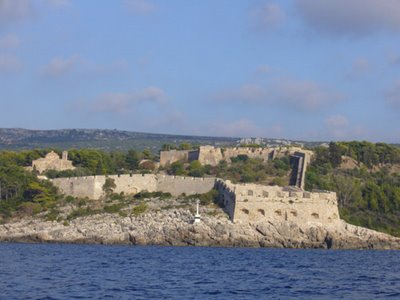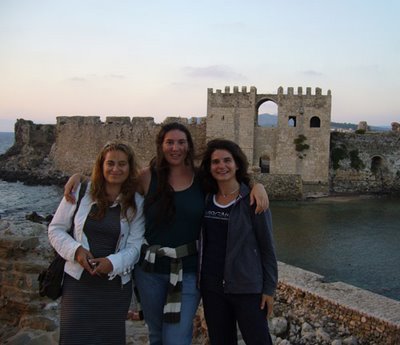
Tegea, Temple of Athena Alea.
Museum is closed for renovations.
Temple of Athena Alea: Scopas was the architect. Ivory cult statue of Atehna, tusks of Calydonian boar stolen by Augustus, etc. 1806 first discovered. 1879- 1st excavations. Early 1900’s, French School. 1940’s – 50’s: Hodge Hill compared it to Nemean Temple of Zeus. 1960’s – continuing excavations. Multinational effort.
Cult buildings from Geometric period, Archaic, Classical. A well – where Herakles raped the nymph Auge who gave birth to Telephus. Geometric/Archaic small finds under the temple. Classical altar. Stadium somewhere around here but not found yet. Maybe under church. Waddle and daub apsidal building: Geometric wooden fence in the apse (W part of building). Probably cultic – found decorated pottery. Another one above it, E-W orientation, apse on W part, where cult statue would have stood. Thus: Cult activity here continuous from Geometric period.
In front: a small metal workshop, roughly contemporary with Geometric buildings – cult again? Above all this – a monumental Archaic temple. Foundation preserved in part.
Supposedly (Paus. says) burned down in 395, replaced by a Classical temple (most of what we see). Remains seem to confirm this date. Scopas 375-330 floruit. He was in 360 in Halicarnassus working on Mausoleum. Looking for Asian influence to date it after 360 (when he came back brough some Asian workers) – some elements of this type do in fact exist. Plus a dedication to Mausolus.
345-335 BCE is a good date. Mostly conglomerate blocks. Two entrances – one to the N, one to the E. Ramp on N: cult? games? somehow related. Procession after games maybe, no stadium to the N though. Access to the Heracles/Auge well (?) leads directly to the cult image.
Temple: Doric peripteral hexastyle exterior, 14 columns down the side (i.e., 6x14). Preserves (?) the Archaic floorplan that preceded it (like at Bassae). Over 80 Doric drums survive. Less from porches – 3 architrave blocks – preserve inscriptions identifying people in the metopes! Local mythological figures/heroes. Unusual metopes: independently carved, then set into the metopes (comparanda: Erechtheion in Athens). Interior: hard to reconstruct. Highly decorated – lots of mouldings. Lower colonnade – frieze topped by moulding. Above that – an Ionic colonnade on top. Little evidence – just some fluting that differs from the Doric/Corinthian fluting. Colonnade on three sides of interior (N,W,S). Π-shaped colonnade. Draws eye toward cult statue. Severe Doric exterior that gives way to the elaborately decorated interior, esp. with light hitting the interior of the cella. Exterior harkens back to the Archaic temple. Columns linked by continuous mouldings.

Athena Alea.

Open-air Water Power Museum.

Byzantine bridge at Karytaina.

Temple of Apollo, Vasses. (Under the tent.)
Fred Cooper, 4 vols. Sculpture in the British Museum. 6km from Phigaleia on Mt. Kotylon. Pausanias dates it to 429 BC, confirmed by pottery. Architect: Ictinus (architect of the Parthenon). The roof and temple are all of stone. Most admirable (for harmony) after Tegea (Athena Alea). Built after the 431 BC plague, during the Peloponnesian War. Set up by the Phigaleians.
Excavations: discovered in late C18. 1811-12: Cockerell, Hollerstein, et al. 1902-08 Greeks excavated here. 1927: Dinsmoor works on the architecture, publishes ideas. 1960’s: Ialouris. Ther was an earthquake that caused a lot of structural damage. Tent went up in 1987. Since 1970, Fred Cooper has been working here.
Temple: Doric peristyle 6x15. Lacks traditional late C5 refinements: no entasis, no upward curvature or inward inclination, no thicker end columns. Archaizing style. All of this makes its date questionable. Maybe earlier than 429. Carved metopes; no pedimental sculpture. Very simple exterior, complex interior – Ionic frieze with engaged Ionic columns. Oriented N-S. East wall has a door to the adyton. Archaic outside, new inside. Maybe Ictinus didn’t build it? Or maybe there were two building phases? Or a deliberate choice of archaizing – this is most likely.
The footprint of the earlier temple is the same as the Ictinus temple (phase IV), except Ictinus’ is peripteral. Archaic temple dated to 600-575. The Archaic temple was excavated: found 2 sets of terra cotta fragments of roof tiles. 1995: Kelly studies roof structure: if you move Phase IC 10 m N you get temple phase I and II (same footprint) – therefore a deliberate decision.
Interpetation: religious conservatism (Kelly). Cooper imagines a Phase III, but most people disagree with a Phase III.
Corinthian Capital: if we entered the E wall door to the adyton, we would see the first example of a Corinthian Capital. Disappeared (fell apart) but we have pieces. Vitruvius says the image comes from Corinth, but we have this one here as our first example. We have Ionic stuff inside, but it doesn’t work in the middle of a room (it’s not 3D) – so Corinthian makes the most sense here. Fully 3D but has same column shaft as Ionic. Continuous tainia frieze (Ionic) in interior. Dinsmoor wants more than one (3 in fact) Corinthian Columns + capitals but this can’t be proven.
The Corinthian column might have been an aniconic cult statue of Apollo. No evidence of an altar back there. Function of Ionic frieze: architectural feature that ties the room together. C5 friezes delimit space, tie together stuff. Herakles is a focal point in the frieze, acts like a ribbon to bind together unrelated space. Frieze: a Trojan Amazonomachy (Penthesileia, Achilles, Telamonian Ajax), Herakleian Amazonomachy (Telamon), Centauromachy (Hippodameia, Dioskouroi, Apollo, Artemis’ sanctuary). Start at NW and go out in both directions; maybe made by Paionios who made Nike at Olympia? Probably not. Shows development of C5-early C4, but poor lighting diminishes it.
British Museum rearranged the frieze; it was unpopular so they put it back the way it was (wrong).
Ictinus: why would he build the Parthenon, and then this local limestone archaic thing? Seems to have been built before Parthenon (archaizing). Parthenon and Bassae don’t cohere together, may be significant. Ictinus (when we know it’s him) makes a Doric exterior, Ionic inside to carry ceiling.

 Me at Osios Loukas Monastery.
Me at Osios Loukas Monastery. The two churches at Osios Loukas.
The two churches at Osios Loukas. Looking out over the valley below Osios Loukas.
Looking out over the valley below Osios Loukas. Head of Apollo in chryselephantine, Delphi Museum. I did a presentation on this in 1999 with CYA! It's still one of my favorites.
Head of Apollo in chryselephantine, Delphi Museum. I did a presentation on this in 1999 with CYA! It's still one of my favorites. View of the theater and temple of Apollo from above. The small building in the upper right corner is the Treasury of the Athenians.
View of the theater and temple of Apollo from above. The small building in the upper right corner is the Treasury of the Athenians. Temple of Apollo at Delphi, from the inside. (Special permit.)
Temple of Apollo at Delphi, from the inside. (Special permit.) The Treasury of the Athenians at Delphi, from the inside. (Special permit.)
The Treasury of the Athenians at Delphi, from the inside. (Special permit.) The gymnasium at Delphi.
The gymnasium at Delphi. The tholos at Delphi.
The tholos at Delphi. The sleepy (in winter) town of Galaxidi, which has a really, really great Nautical Museum. Best thing about the town.
The sleepy (in winter) town of Galaxidi, which has a really, really great Nautical Museum. Best thing about the town. The theater with the straight rows at Kalydon. Although no doubt a very important site (this theater is really interesting), the most notable thing about the site of Kalydon is the hoards of mosquitoes. I counted forty mosquito bites on myself before I gave up. Miraculously, they all disappeared within a day.
The theater with the straight rows at Kalydon. Although no doubt a very important site (this theater is really interesting), the most notable thing about the site of Kalydon is the hoards of mosquitoes. I counted forty mosquito bites on myself before I gave up. Miraculously, they all disappeared within a day. The heroon at Mesolonghi, for the Greek War of Independence.
The heroon at Mesolonghi, for the Greek War of Independence. The theater at Stratos. In case you're wondering what's going on with all the theaters everywhere, I'm writing my dissertation on them.
The theater at Stratos. In case you're wondering what's going on with all the theaters everywhere, I'm writing my dissertation on them. John demonstrates one method of entering an archaeological site (here, Stratos).
John demonstrates one method of entering an archaeological site (here, Stratos). Steven demonstrates the other method.
Steven demonstrates the other method. The Roman baths at Nikopolis.
The Roman baths at Nikopolis.











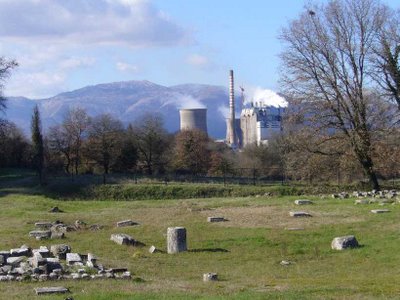

 Chamber tomb at Thourion.
Chamber tomb at Thourion.
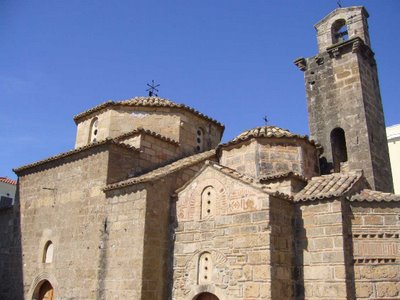
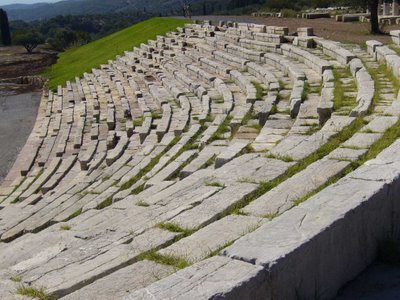




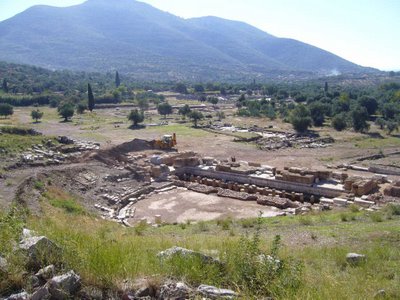
 Tholos tomb at Nichoria.
Tholos tomb at Nichoria.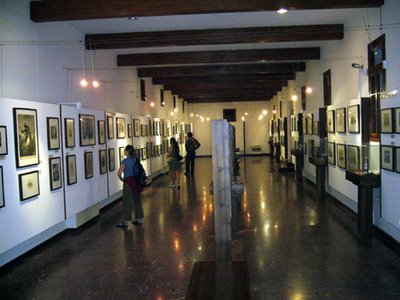 The Museum inside the Neokastro.
The Museum inside the Neokastro.
